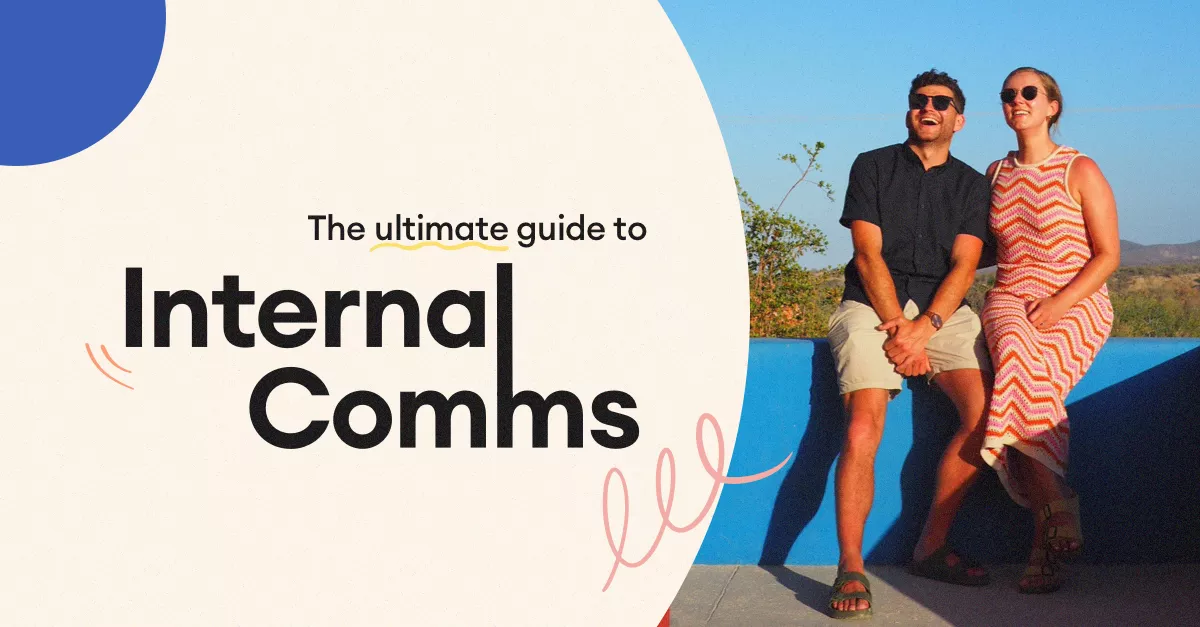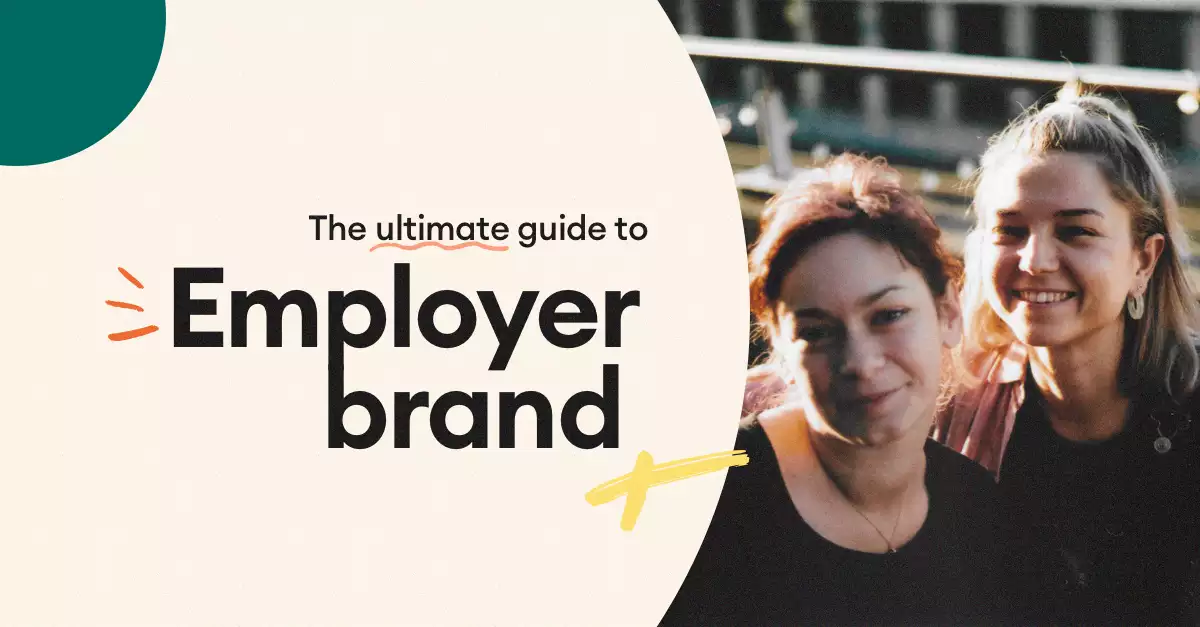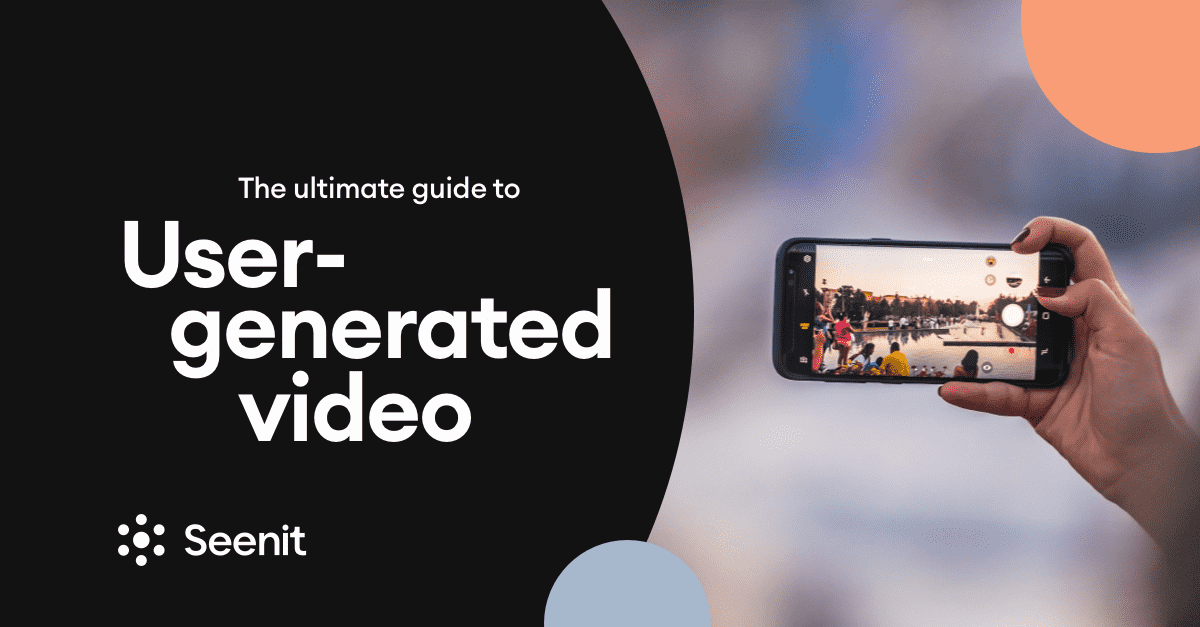User-generated video (UGV) is fast-becoming one of the most effective mediums in your brand’s arsenal. It builds trust, provokes emotion, and establishes that all-important human connection with the audience. Not only that, but UGV can significantly reduce the time and cost involved in the production process.
A form of user-generated content or UGC, user-generated video is video content produced by an individual with their own camera. Video co-created by fans about the brands they love provides one of the biggest opportunities for organisations to stand out.
Plus, where traditional video production depends on a filming crew, professional equipment, and film studios, UGV keeps things simple.
**All you need to get started is the smartphone in your pocket **
The exponential growth in TikTok and Instagram served as evidence of the power and potential of UGV. And, given that videos are set to account for 82% of internet traffic by 2022, it figures that brands and businesses are taking note. Responding to the rise in demand for authentic content, professionals ranging from HR & Internal Comms to Marketing and Advertising are changing tact. More than ever, they’re putting the focus on their people and exploring the potential of crowdsourced videos to drive engagement.
If you’re new to UGV, don’t worry: it’s all about experimentation. There’s no one-size-fits-all approach - so be bold, play around with different formats, and don’t be afraid to make mistakes. If you need a steer in the right direction, check out our Film School for tips on turning your community into your best film crew.
Seenit has championed the power of user-generated video from the beginning. Through our platform, leading brands like Spotify, Amazon, ING, Novartis, Viacom and more have tapped into the potential of user-generated video.In the following guide, we share our top tips for UGV production and brilliant examples to inspire your next project.
UGV: The new normal in video production
2020 changed everything. Overnight, the fast-paced world of business was forced to put the breaks on and re-evaluate. The professional video production industry was turned on its head: no more film sets, crew rosters and crowded editing suites. Travel wasn’t an option; budgets were slashed and the traditional methods for producing professional video were suddenly under threat.
Out of enforced change came opportunity
From newsrooms to advertising teams and internal communications, the shift from professional production to user-generated video accelerated. The bells and whistles of high-production-value videos didn’t matter anymore. What mattered was the content - or more accurately, the stories.
With news presenters broadcasting from their bedrooms and talk show hosts swapping stylish studios for their own settees, a sense of solidarity grew. Embracing change was the only viable option, and UGV emerged victorious as the human way to tell stories.
Audience expectations have changed
The lockdown restrictions that kept people apart increased the need for human connection. Alongside it, the demand for honesty and authenticity arose. It wasn’t the airbrushed influencers who came out on top, but the brands who spoke from the heart. Footage of initiatives like as #ClapForCarers and Captain Tom’s fundraising efforts shone the spotlight on the everyday individual.
Expectations had evolved from stylised content to empathy and understanding. Audiences sought genuine, no-filter stories. Stuck in an unprecedented crisis with no end in sight, many found solace in collaborative storytelling and the sense of togetherness it brought about.
Increasingly, people began to realise that they didn’t need big budgets and expensive equipment to tell an impactful story. Equipped with the smartphones in their pockets and laptops on their desks, they took what they had and got creative.
**The outcome was storytelling in its purest form **
Experts, frontline workers, and everyday individuals all contributed to the conversation, communicating their own unique perspectives through their own camera lens. Brands embraced the new normal as a chance to engage their communities. They didn’t achieve this through overblown ad campaigns, but with crowdsourced videos that involved them in the conversation. Meanwhile, leadership teams found the medium ideal for demonstrating togetherness during difficult times. HR professionals discovered the potential of UGV in driving inclusive cultures, boosting morale and celebrating the achievements of employees.
Ultimately, what began as a popular social media trend had become an outlet for human connection. User-generated video is here to stay, and fortunately, it’s easier than ever to produce.
Top tips for UGV production
You don’t need a big budget to compete in an ever-crowded digital space. You already have a community of people bringing different perspectives - you just need to leverage it. Together with your community, you can tell impactful stories that provoke emotion and spark engagement. Not only is user-generated video easier to produce, but research shows this format delivers higher levels of engagement than any other. That’s because UGV comes straight from the heart; the stories told are honest, authentic, and provoke empathy.
Films created by the people themselves as opposed to the professionals provide fly-on-the-wall footage of those closest to the brand - whether they’re loyal customers, business leaders or happy employees. But what’s the best way to begin producing impactful UGV?
**Know your why **
Before you set out on your crowdsourced video journey, make sure you have a goal in mind. Simon Sinek famously talked about the importance of knowing your “why” to inspire action - the same goes for UGV. Your “why” will inform everything from who you invite to how you tell your story. So, defining your purpose should come first on your list. Remember to clearly communicate this purpose to your contributors - the more open you are about your “why”, the more open they will be in their response.
**Involve the right people **
Keeping your defined goal in mind, ask yourself who in your community is best placed to tell your story, and why.
For example, if it’s a story around employee wellbeing, those specialising in this area will have expert opinions to share. But it may also be worth involving others who are already acting as advocates for mental health on their personal channels. Since they’re passionate about the subject and confident enough to speak up on it, their contribution will add another dimension to the content. If the story centres around themes of diversity and inclusion, involving people who are closest to these issues is a no-brainer.
If you get the right people in the room at an early stage, you’ll find the content is enriched with valuable insights. What’s more, you’ll also boost engagement by getting them actively involved with your brand. You may even see a domino effect by putting the ask out there as more people within your community feel empowered to get involved.
**Storyboard **
Ahead of briefing your contributors, set out a plan for your vision of the video. The easiest way to do this is by storyboarding. A storyboard is a comic-strip style representation of your film. It doesn’t need to be clean, or even exact - a storyboard simply acts as a guide that helps break down what your project will look like.
Once you’ve put together a rough storyboard, you’ll feel a lot less intimidated by the work ahead: it’ll just be a case of bringing it to life. To make it even easier, use our storyboard template and start drawing out what you have in mind.
Top tip: Don’t just think of the story you want to tell - think ofhow *you can tell it, too. *
Build trust in advance
Sent out a mass-email to your contributors and getting nothing back? You can’t expect people to bite on your brief if you don’t create a supportive culture that empowers them to get involved. The more work you can do upfront to build trust with your community, the better the content they will produce in response. Where possible, schedule in-person or virtual sessions to inform your contributors of your goals and ask for their input. Make your people feel their contribution is valued and their engagement with the project will grow.
**Don’t over-complicate **
This isn’t a case of ‘Go Big or Go Home’.
After all, UGV is powerful because it’s simple, stripped back, and to the point. Don’t over-complicate the project by setting unrealistic expectations. Keep it simple - not just for your story’s sake, but for the sake of your contributors. People are more likely to take part if the brief is straightforward. Think quality over quantity: you often don’t need as many contributions as you think to tell an impactful story.
**Set a short deadline **
Simply put, the further the deadline, the less pressing it is to the business and the people involved. It may not seem like an urgent project, but the transformation in culture it can bring about (not to mention customer engagement) isn’t something worth putting off. Set a short deadline to keep the project front of mind - you can always extend it if need be.
Don’t set and forget
Communication at every step is vital to the success of the project. You can’t expect the content to fall on your lap after one invite or informal chat. Maintain momentum by keeping an active channel of communication around the project. You can use it to share ideas, check on progress and set expectations around timescales.
**A quick guide to keeping it real **
The unparalleled authenticity of good UGV is one of its main draws. The more genuine and honest the video, the more your audience will connect with it on a human level. This in mind, here are some steps you can take in the process to help authenticity flourish:
Show, don’t tell
If you’ve ever heard the phrase “lead by example”, this is the perfect time to put that to action. Don’t just tell your community what you want - show them. Your community will be more responsive to a video introduction that asks them to contribute and sets the tone for the story.
Set the bar at an achievable standard and you’ll usually find your contributors feel more comfortable getting started. They’ll see the ask is straightforward and feel more at ease having seen an example. On average, we see around 50% more uploads for stories that have an intro video, so practice what you preach and lead the way.
**Reassure your contributors **
Not everyone feels comfortable on camera. For some of your contributors, it could be the first time they’re filming themselves. So, always make an effort to create a sense of togetherness and reassure those involved that nerves are perfectly normal. Any tips you can give them to help them feel comfortable on camera will be much appreciated. For example: “If you feel weird speaking into a camera by yourself, why not get a friend to film you and pretend you’re talking to them?” Or, “If you aren’t feeling at ease, you should film somewhere you feel comfortable.” Ultimately, your job is to support your contributors to get the best content out of them. The more help you can give, the less daunting the task will be to them.
Avoid over-scripting
Sometimes, the best moments in movies are the impromptu, unscripted lines that were delivered off the cuff. Over-scripting isn’t just overwhelming, but it can stifle creativity. Remember, this is collaborative storytelling: guidance is helpful, but you don’t want to squander the authenticity that makes UGV so powerful. Unless they’re professional actors (which they aren’t), the audience will be able to tell they’ve memorised words off a page. Keep your brief clear but your script loose: people will often surprise you with their interpretations and creativity.
**Don’t cast your net too wide **
As valuable as a multitude of perspectives on one subject can be, you don’t want the final result to come across as bloated. You may be tempted to invite anyone and everyone to make sure you get contributions, but you usually won’t need as many uploads as you think. The people who care will give you the best content. So, identify the right type of people your project should involve and set out to find them.
*Top tip: **It may be worth involving figureheads who your prospective contributors will recognise. This will inspire the right people to get involved and prevent you from casting the net so wide that you end up with too much content and no clear narrative. *
Filming tips to enhance your story
You don’t need a film studio and camera crew to create compelling UGV. However, it doesn’t hurt to keep a view on the storytelling itself, and to take advantage of the tools you have to amplify your message. Your contributors won’t need a crash course in film production, but a little guidance and top tips can make all the difference.
Educate
We talked previously about the importance of an intro video. This is the perfect opportunity to educate your contributors on best/worst practice. You can use this to show them examples of poor UGV, such as dimly lit environments, bad audio, or shaky cameras. You can also use your intro video to showcase to your contributors some examples of successful UGV. We made our Film School to help brands educate their contributors on the basics of filming. Whether in an intro video or as part of your invitation, share some tips with your community to get the best quality content back. It’ll make the job of editing a lot easier.
**Collect B-roll **
B-roll is the film industry’s term for supplementary footage that is intercut with the main footage. It’s not always essential, but filming yourself several times from different angles can help to enrich your video content. Although it’s not critical to great UGV content, it can help to bring content to life in the editing phase. Throw the idea out there in your intro video.
Don’t try to emulate the pros
This is UGV - you aren’t angling for the Oscars, and neither are your contributors. The whole purpose of the medium is authenticity, so don’t try too hard to film like the professionals. By all means, experiment with angles, collect B-Roll, and film in well lit environments. But don’t get lost in the composition. The most important element, after all, is the story.
**Don’t make it an afterthought **
You’ll never have full control over how the final video will look, but that’s part of the beauty of UGV. If you have a clear idea of how you want your video to look, communicate this with your contributors from the get-go. It can be as simple as clear backgrounds to allow for text or filming in landscape mode to avoid those pesky sidebars of portrait mode.
**Best practice advice for editing your UGV **
When you’re a complete beginner, bringing a collection of uploads together into one final output can feel like an impossible feat. Fortunately, Seenit makes the editing process much easier. That said, if you do have someone well-versed in video editing, involve them in the project early on and lean on their expertise. If not, don’t worry too much - the following tips will certainly give you a head start.
Bring the board back out
Take the content you receive and compare it with your storyboard: where would certain uploads fit best? Can you envision a linear flow to your story with the content you have? Go through all your footage and find the best visuals, the best sound bites and any B-Roll that will be useful. Uploads will naturally start to fall into the beginning, middle or end of your story based on how they look or the message they convey.
Less is more
Not all videos will make the cut - and you shouldn’t feel bad about that. Reassure your contributors that any unused footage can be used in upcoming projects. Some clips may have only a few seconds of great content - if that’s the case, cut it down and store the rest. It could come in handy in the future.
Use music to your advantage
If you find your narrative isn’t clear enough, use music to evoke a mood or tone. You can always play around with volume, bringing the audio of the track down when people on screen are talking, and ramping it back up during compilations of action. For a great example of this, check out Tilney Smith & Williamson’s 5K Charity Run UGV.
Getting the most from User-Generated Video
In 2020, HubSpot research showed 91% of marketers felt the pandemic had made video more important for brands. We couldn’t agree more. No matter what the future holds, one thing is for certain: humans crave emotional connection, and user-generated video is uniquely placed to deliver it.
Producing powerful UGV content takes commitment. Before you can reap the rewards of this medium, you need to lay the right foundations. That means getting the conversation started early, and building trust with your community. The more excitement you build around the project and support you give in the process, the better the final result.
At Seenit, we love supporting organisations of all sizes on their User-Generated Video journeys. From internal comms to marketing campaigns, you can bring your values to life using the technology that already exists in the business. If this feels a little daunting, don’t worry - it’s far easier than you may think. Using Seenit, you can easily collect uploads from your community, wherever they are in the world, and turn it into content that turns heads. Simply share the story you want to tell with your community, and use Seenit to turn your people into a mobile film crew.
When the time comes to edit, you’ll have the pleasure of weaving together a compilation of brilliant videos that cast the spotlight on the incredible people within your community.



